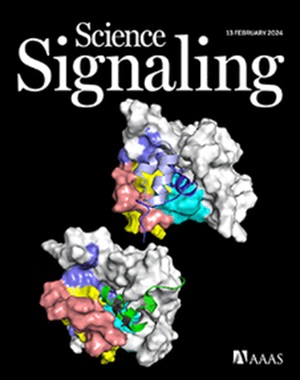心肌细胞中PTP1B的缺失改变了心脏代谢信号,以防止高脂肪饮食引起的心肌病
IF 6.6
1区 生物学
Q1 BIOCHEMISTRY & MOLECULAR BIOLOGY
引用次数: 0
摘要
心肌细胞(CMs)通常使用脂肪酸氧化(FAO)作为其主要能量来源。在病理应激下,CMs对底物的偏好从FAO转变为葡萄糖代谢,导致心力衰竭的发生。肥胖增加了心血管疾病的病理风险。我们专注于蛋白酪氨酸磷酸酶1B (PTP1B),一种胰岛素信号抑制剂,其丰度和活性在肥胖和/或糖尿病动物和肥胖人类患者的脑、肌肉和脂肪组织中增加。我们制造了cm特异性PTP1B (PTP1Bfl/fl::ꭤMHCCre/+)缺乏的小鼠,以研究PTP1B在高脂肪饮食(HFD)喂养引起的心功能障碍中的cm特异性作用。虽然在基线时没有观察到生理或功能上的差异,但PTP1Bfl/fl::ꭤMHCCre/+小鼠可以防止HFD喂养引起的心脏肥大、线粒体功能障碍和心脏脂肪变性的发生。代谢组学数据显示,cm特异性缺失PTP1B的心脏增加了FAO和脂肪分解,但降低了葡萄糖代谢。此外,磷酸化蛋白质组学分析和机制研究发现了心脏中PTP1B下游PKM2和AMPK激酶的轴,它们共同促进FAO和抑制脂肪生成。总之,这些结果表明,cm特异性的PTP1B缺失阻止了从FAO到葡萄糖代谢的底物转换,保护心脏免受hfd诱导的心脏肥厚和功能障碍的发展。本文章由计算机程序翻译,如有差异,请以英文原文为准。

Deletion of PTP1B in cardiomyocytes alters cardiac metabolic signaling to protect against cardiomyopathy induced by a high-fat diet
Cardiomyocytes (CMs) normally use fatty acid oxidation (FAO) as their primary energy source. In response to pathological stress, the substrate preference of CMs switches from FAO to glucose metabolism, leading to the development of heart failure. Obesity increases this pathological risk of cardiovascular disease. We focused on protein tyrosine phosphatase 1B (PTP1B), an inhibitor of insulin signaling, the abundance and activity of which are increased in brain, muscle, and adipose tissues in obese and/or diabetic animals and in obese human patients. We generated mice with CM-specific deficiency in PTP1B (PTP1Bfl/fl::ꭤMHCCre/+) to investigate the CM-specific role of PTP1B in response to cardiac dysfunction induced by high-fat diet (HFD) feeding. Although no physiological or functional cardiac differences were observed at baseline, PTP1Bfl/fl::ꭤMHCCre/+ mice were protected against development of cardiac hypertrophy, mitochondrial dysfunction, and cardiac steatosis induced by HFD feeding. Metabolomics data revealed that hearts with CM-specific deletion of PTP1B had increased FAO and lipolysis but reduced glucose metabolism. Furthermore, phosphoproteomics analyses and mechanistic studies identified an axis involving the kinases PKM2 and AMPK downstream of PTP1B in the heart, which collectively acted to promote FAO and suppress lipogenesis. Together, these results suggest that CM-specific deletion of PTP1B prevents a substrate switch from FAO to glucose metabolism, protecting the heart against the development of HFD-induced cardiac hypertrophy and dysfunction.
求助全文
通过发布文献求助,成功后即可免费获取论文全文。
去求助
来源期刊

Science Signaling
BIOCHEMISTRY & MOLECULAR BIOLOGY-CELL BIOLOGY
CiteScore
9.50
自引率
0.00%
发文量
148
审稿时长
3-8 weeks
期刊介绍:
"Science Signaling" is a reputable, peer-reviewed journal dedicated to the exploration of cell communication mechanisms, offering a comprehensive view of the intricate processes that govern cellular regulation. This journal, published weekly online by the American Association for the Advancement of Science (AAAS), is a go-to resource for the latest research in cell signaling and its various facets.
The journal's scope encompasses a broad range of topics, including the study of signaling networks, synthetic biology, systems biology, and the application of these findings in drug discovery. It also delves into the computational and modeling aspects of regulatory pathways, providing insights into how cells communicate and respond to their environment.
In addition to publishing full-length articles that report on groundbreaking research, "Science Signaling" also features reviews that synthesize current knowledge in the field, focus articles that highlight specific areas of interest, and editor-written highlights that draw attention to particularly significant studies. This mix of content ensures that the journal serves as a valuable resource for both researchers and professionals looking to stay abreast of the latest advancements in cell communication science.
 求助内容:
求助内容: 应助结果提醒方式:
应助结果提醒方式:


